SEStran 2035 Regional Transport Strategy
The Regional Transport Strategy (RTS) provides the framework and direction for transport in the south east of Scotland. South east of Scotland is made up of The City of Edinburgh, Clackmannanshire, East Lothian, Falkirk, Fife, Midlothian, the Scottish Borders and West Lothian – approximately a third of Scotland’s population.
We’re required to produce a Regional Transport Strategy by the Transport (Scotland) Act 2005, and the Regional Transport Strategy should provide a strategic framework for transport management and investment for the partnership area.
The Regional Transport Strategy follows on from our 2008-2023 strategy and 2015-2025 refresh document. The document has been prepared in accordance with Regional Transport Strategy development guidance (Transport Scotland, 2006), the Scottish Transport Appraisal Guidance (STAG) and all relevant legislative and policy requirements. Read the Regional Transport Strategy preparatory work.
The Regional Transport Strategy shapes our thinking and work, in particular, our other strategies:
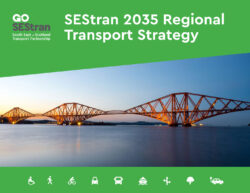
SEStran 2035 Regional Transport Strategy
View the full document
The link below will allow you to open the entire document. You can also open the pdf at individual sections by scrolling further down this page.
Open PDF at the beginningSome mobile devices and browsers may not allow the PDF to be opened at a specific section as intended via the button above. Please use the content quicklinks at the beginning of the document if required.
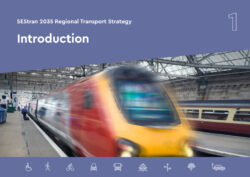
Introduction
Sections 1–3
Section 1: Introduction
This Regional Transport Strategy (RTS) for the South-East of Scotland has been prepared by the South-East of Scotland Regional Transport Partnership (SEStran) which was set up under the Transport (Scotland) Act 2005. It covers eight constituent local authorities as shown in Figure 1.1. This Act also set the requirement to produce a statutory RTS to provide a strategic framework for transport management and investment for the Partnership area.
Section 2: Context
The SEStran region covers 8,400km2 which is just over 10% of Scotland’s landmass. It is hugely diverse and includes areas which fall into every one of the Scottish Government’s six-fold urban-rural classification. The total population of the SEStran area was estimated as 1,609,070 in 2019. The majority of the population is concentrated in the centre of the SEStran area with a large, sparsely populated rural area to the south particularly the remote rural areas in Scottish Borders and East Lothian. The greatest concentration of population is within the City of Edinburgh which accounts for approximately 33% of the total SEStran region population. Figure 2.1 illustrates the breakdown of the region using the Scottish Government’s 6-fold urban – rural classification which highlights how much of the area is classified as rural. The RTS considers transport issues and opportunities across all areas of the region.
Section 3: Transport Challenges in the Region
Developing the RTS starts from a set of transport problems and, to a lesser extent, transport opportunities. To be meaningful to the public, the transport problems which the RTS is aiming to address must reflect problems experienced in everyday life by individuals, organisations, and businesses in the SEStran area. These vary across the region with those being experienced in rural areas often differing from those in urban areas.
Open PDF at Section 1Some mobile devices and browsers may not allow the PDF to be opened at a specific section as intended via the button above. Please use the content quicklinks at the beginning of the document if required.
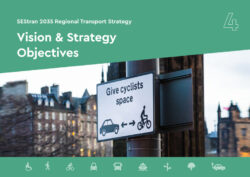
SEStran 2035 Vision
Section 4
Section 4: Vision & Strategy Objectives
The vision for the RTS has been developed to reflect new national, regional and local policy priorities. It sets out the type of region we want the South East of Scotland to be and how transport can contribute to achieving that for everyone. The vision also shapes the strategy objectives by providing a high-level context and long-term focus for the strategy.
Open PDF at Section 4Some mobile devices and browsers may not allow the PDF to be opened at a specific section as intended via the button above. Please use the content quicklinks at the beginning of the document if required.
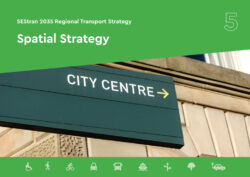
Space and Place
Sections 5–6
Section 5: Spatial Strategy
The RTS sets out a range of policies and actions which will shape investment in, and the management of transport in the region for the next 10 to 15 years. Crucially, in response to the Climate Emergency the Scottish Government has set a target to reduce car traffic levels (car km) by 20% by 2030. This is a fundamental point for the RTS to address and it is therefore important to understand car-based travel in the SEStran area to appropriately focus initiatives aimed at reducing car-km. Whilst providing a framework for all travel and transport in the region, the RTS has a particular focus on regional travel, i.e., travel between local authorities as opposed to travel wholly within local authority areas. To understand this, although now dated, the census of 2011 provides the most comprehensive and detailed picture of (pre COVID-19) commuting travel in the SEStran region – this is taken as a proxy for all travel for the purposes of analysis here. Typically, commuting sees a higher share of public transport than for other travel so if anything, this may underestimate the scale of the ‘problem’.
Section 6: Shaping Development and Place
Transport plays an essential role in linking land-uses and enabling people to get where they need to go. People travel to get to employment, essential services, leisure facilities, where they live and other land-uses so it is key that the transport system caters for this demand in an effective, efficient and sustainable manner. In addition, transport also contributes to our built environment playing an active role in placemaking and the attractiveness of spaces to live, work, visit and spend time in.
Open PDF at Section 5Some mobile devices and browsers may not allow the PDF to be opened at a specific section as intended via the button above. Please use the content quicklinks at the beginning of the document if required.
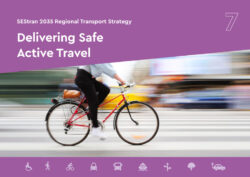
Transport Modes
Sections 7–10
Section 7: Delivering Safe Active Travel
Enabling safe active travel in the region requires the provision of integrated and high-quality routes for walking, wheeling and cycling that join up settlements and destinations. This is essential to support the vital role walking and wheeling has to play to enable people to make healthy living choices and assists in delivering places that are happier, more inclusive and equal, and more prosperous
Section 8: Enhancing Access to and Accessibility of Public Transport
Providing access to public transport safe to use for all is essential to ensure that the region realises a transition to decarbonised transport network in an inclusive manner. Transport is essential to enable people to access employment and essential services like healthcare, retail and education but some people face physical and other barriers that prevent them from using the public transport services that provide these links. This can lead to disadvantage, social exclusion, deprivation and is a major driver of transport poverty. Furthermore, the impacts tend to be most acute for the most vulnerable groups within the region such as the elderly, the young, those with disabilities or mobility impairments, ethnic minorities, women and people on low incomes.
Section 9: Transforming and Extending the Bus Service
The bus network is at the heart of the region’s public transport system. Almost half (47%) of residents of the region used a bus service at least once a month in 2019. This figure is heavily skewed by Edinburgh though – if Edinburgh residents are excluded, this figure drops to an average of 34%. However, demand has been heavily impacted by the COVID-19 pandemic. To realise our aspirations to decarbonise the region and provide sustainable, affordable access for all, bus services will need to play a pivotal role. The RTS therefore sets out a foundation that seeks to rebuild demand for buses in the wake of the pandemic and that firmly places the role of buses at the centre of the strategy.
Section 10: Enhancing and Extending Rail Services
The rail network (comprising ‘conventional’ heavy rail and the light rail / tram) plays a key role linking up the region as well as providing connectivity to external locations. The region has benefitted from the construction of the Borders Railway which opened in September 2015. The line carried 1,737,000 passengers by the end of its fourth year of operation (October 2019) which is over 22% more than during its first year. Whilst demand has subsequently been impacted by the COVID-19 pandemic this nonetheless highlights the role that new rail infrastructure can have in driving public transport usage across the region. Indeed, evaluation published by Transport Scotland of both the Borders Railway and Airdrie Bathgate Rail Link (opened in 2010) has demonstrated the value of these investments to the SEStran area.
Open PDF at Section 7Some mobile devices and browsers may not allow the PDF to be opened at a specific section as intended via the button above. Please use the content quicklinks at the beginning of the document if required.

Transport Goals
Sections 11–15
Section 11: Facilitating Efficient Freight Movement and Passenger Travel
The efficient movement of people and freight around the region requires high quality transport networks which are fit for purpose and that minimise the impacts of congestion and delays on journey times. To achieve this in some instances there is likely to be a requirement for targeted infrastructure investment particularly aimed at tackling congestion hotspots. On the strategic road network whilst traffic management will be key these should also incorporate bus priority and active travel measures where relevant and practical.
Section 12: Reallocating Roadspace on the Regional and Local Network
Encouraging more people to use public transport and active travel will depend upon the provision of high-quality infrastructure that makes these modes as attractive as possible in comparison to car. In some instances, this may require parts of the road network to be reallocated in order to give greater priority to alternative modes.
Section 13: Delivering Seamless Multi-Modal Journeys
nhancing the integration between modes reduces the barriers to interchanging between different types of transport which are often perceived as a significant impediment to users, and will lead to a transformational change in how the transport network is accessed and used. The role of walking and wheeling as an integral part of the end to end multi modal journey and the importance of how this active travel part of the trip links to other sustainable transport
modes is a key element of the overall journey. The delivery of a more seamless transport network for the region will make travelling by public transport and active travel more attractive for a wider range of journeys and reduce the high levels of car dependency with 64% of journeys to work by residents of the region being made by car drivers or passengers in 2019. This seamless transport network will be aided through an integrated ticketing scheme incorporating fare capping and measures to reduce two fare trips or a more targeted initiative. To be truly effective these schemes need to operate across different operators and modes.
Section 14: Decarbonising Transport
In the SEStran region, the transport sector is responsible for over 26% of CO2 emissions , the majority of which derives from road transport, which is highly dependent on fossil fuels. This high contribution to emissions has detrimental impacts on the environment, ecosystems, and air quality notably for those living in densely populated urban areas and near main roads. As the Scottish Government is aiming to phase out the need for new petrol and diesel cars by 2030 as outlined in the Update to the Climate Change Plan Update published in December 2020, it is paramount to critically consider alternative fuels and environmentally friendly technologies, not only for cars, but across the transport sector. Overall, a holistic solution is required to decarbonise the transport sector which prioritises the sustainable travel hierarchy. However, where travel by private vehicle is necessary it is essential that a transition to alternative fuel sources is facilitated to minimise carbon emissions.
Section 15: Reducing Car Kilometres
The Scottish Government has set out a target to reduce car kilometres in Scotland by 20% by 2030. Reducing the dominance of private cars offers significant benefits both to individuals and wider society, including improved health and wellbeing, reduced inequalities, and more inclusive economic prosperity. Reducing car use will also improve our public places, making them more attractive, safer and healthier spaces in which to live, work and spend leisure time.
Open PDF at Section 11Some mobile devices and browsers may not allow the PDF to be opened at a specific section as intended via the button above. Please use the content quicklinks at the beginning of the document if required.
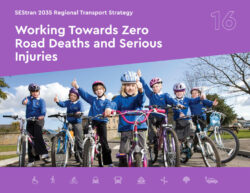
A Safer Network
Section 16
Section 16: Working Towards Zero Road Deaths and Serious Injuries
The number of reported road collisions to Police Scotland in the region has decreased by 43% between 2010 and 2019. This demonstrates a general trend towards improving road safety. It is important to build upon this success by implementing further road safety measures across the region. These should be targeted at locations with collision clusters on both the strategic and local road network. Whilst it is important to minimise the number of incidents that occur on our road network, the priority is to reduce the number of casualties and interventions should focus on delivering this. In some instances, there will be merit in implementing higher value road safety improvements to engineer out risks at locations where collision clusters continue to occur. This could include more significant infrastructure measures such as roundabouts, junction amendments and carriageway widening.
Open PDF at Section 16Some mobile devices and browsers may not allow the PDF to be opened at a specific section as intended via the button above. Please use the content quicklinks at the beginning of the document if required.

Post Covid
Section 17
Section 17: Responding to the Post COVID-19 World
The COVID-19 pandemic and its potential aftermath has introduced a high degree of uncertainty into all aspects of transport planning. The short-term picture (during the pandemic and the various levels of restriction) is well understood with the impacts on transport demand in Scotland illustrated in the report.
During the pandemic there has been a decline in public transport usage whilst cycling and car use has increased. Walking is down overall but has fluctuated and at times has been above pre-pandemic levels. Demand for all modes has been noticeably impacted by the level of restrictions in place at a given time whilst active travel can also be seen to be seasonal and weather dependent as well. Latest data from the Department for Transport suggests that, as of February 2022, all traffic is around 97% of pre-pandemic levels but both HGVs and LGVs are above their March 2020 levels. Bus is only around 74% of pre-pandemic demand whilst rail is only at 58%.
Open PDF at Section 17Some mobile devices and browsers may not allow the PDF to be opened at a specific section as intended via the button above. Please use the content quicklinks at the beginning of the document if required.
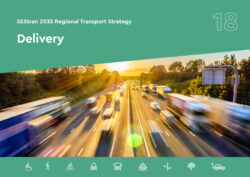
Monitoring and Delivery
Sections 18–19
Section 18: Delivery
The RTS is a long-term strategy intended to provide the policy context for the south east of Scotland over a 10 to 15 year horizon. However, the successful delivery of the strategy will require close partnership working between SEStran, its constituent local authorities, Scottish Government / Transport Scotland, and other key industry stakeholders to take forward the actions and implement the policies set out within this document. In addition, an ongoing programme of interventions (both physical and non-physical) will be required to deliver the vision of the RTS. These will be identified throughout the lifetime of the strategy by supporting analysis and appraisal work following the framework set out here.
Section 19: Monitoring
It will be crucial to monitor the RTS to understand its success in delivering the Strategy Objectives and Vision. A set of Key Performance Indicators (KPIs) linked to the Strategy Objectives has therefore been defined and set out below. The KPIs closely reflect those developed for the purposes of monitoring the National Transport Strategy 2. These will be used to measure the change in the performance of the transport system of the region against an established baseline initially established through the STAG Case for Change report prior to the implementation of the RTS.
Open PDF at Section 18Some mobile devices and browsers may not allow the PDF to be opened at a specific section as intended via the button above. Please use the content quicklinks at the beginning of the document if required.
SEStran 2035 Post Adoption Statement
The South-East of Scotland Transport Partnership (SEStran) 2035 Regional Transport Strategy (RTS) received ministerial approval on 21st March 2023 and was also approved by the SEStran Partnership Board on 31st March 2023. This document is the Post Adoption Statement (PAS) for the Strategic Environmental Assessment (SEA) of the SEStran RTS. The PAS has been prepared on behalf of SEStran, the Planning Authority, by Stantec UK Ltd in accordance with the requirements of the Environmental Assessments (Scotland) Act 2005 (2005 Act).
Read the Post Adoption Statement
If you require further information and the supporting appendices (which are not included in the attached summary) then please contact us via our contact page with ‘Post Adoption Statement’ in the message body.

